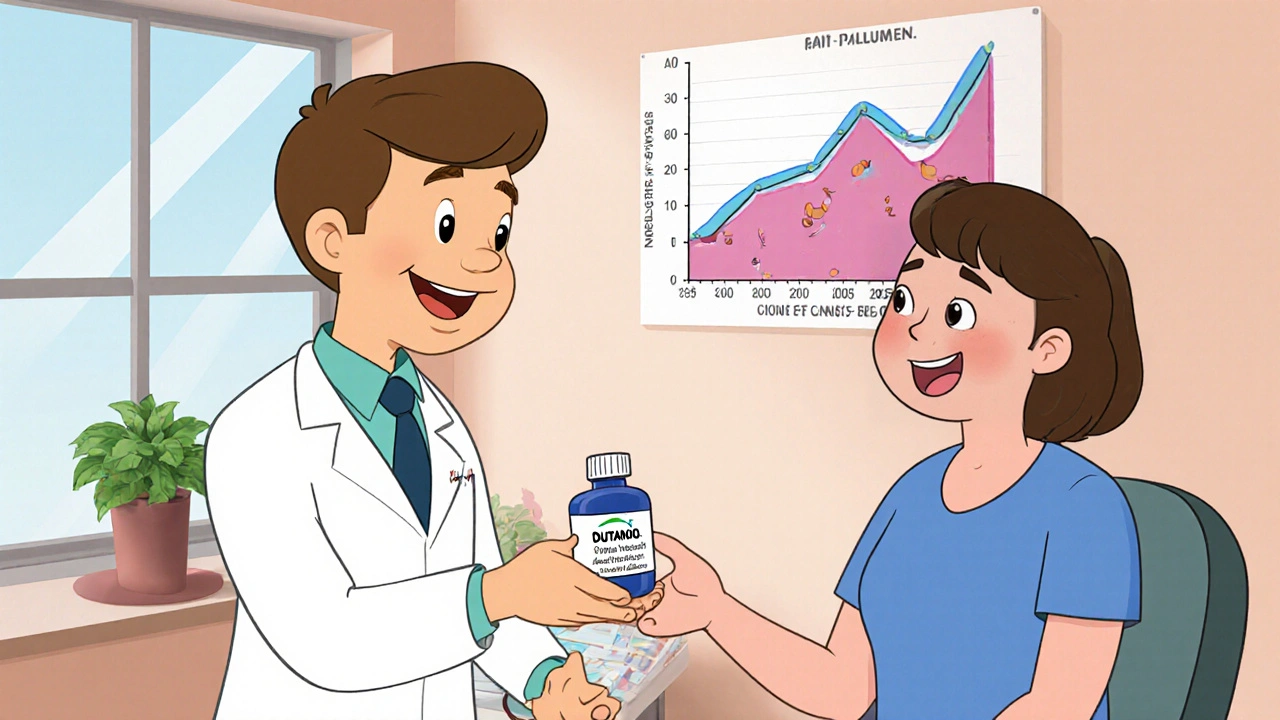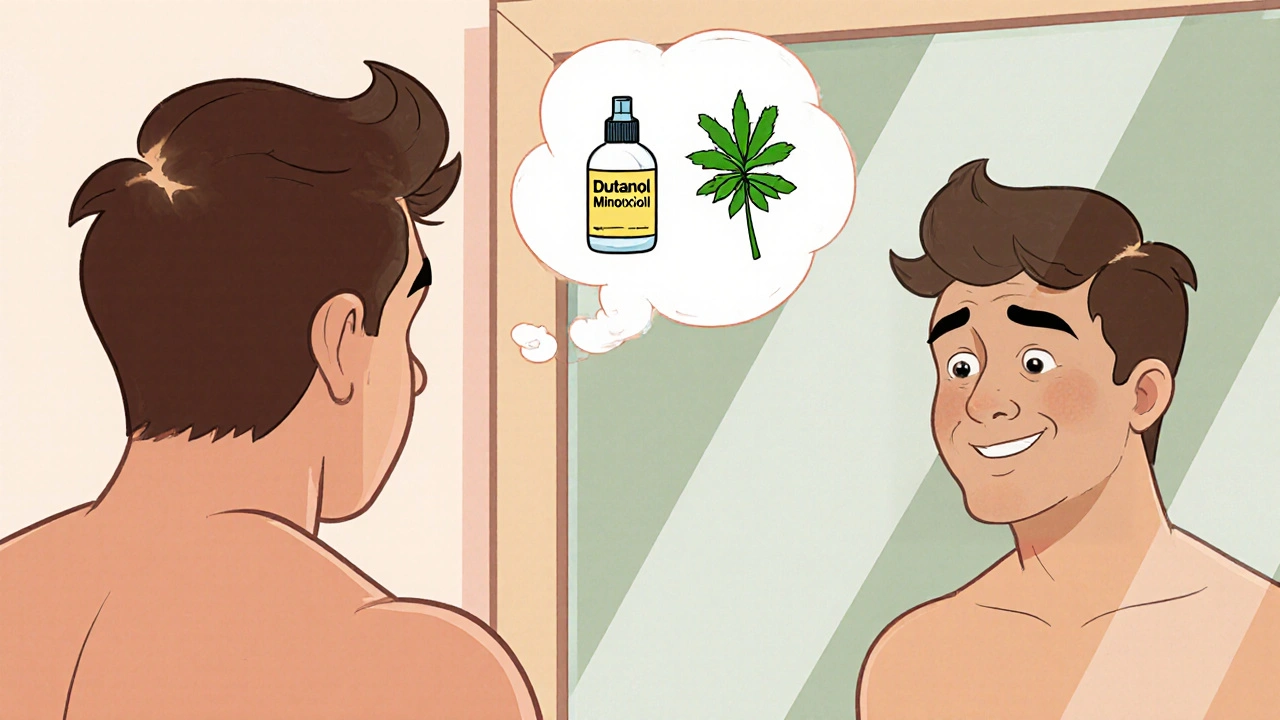Hair Loss Treatment Matchmaker
Which treatment fits you best?
Answer 3 quick questions to see personalized recommendations based on the latest clinical data.
When hair thinning becomes noticeable, the first question is usually "what works best?" Dutasteride (often marketed as Dutanol) has moved into the spotlight as a powerful option, but it isn’t the only game‑changer on the market. This guide breaks down how Dutasteride stacks up against the most common alternatives, what side‑effects you might expect, and how to decide which route fits your lifestyle.
Key Takeaways
- Dutasteride blocks both type I and II 5‑α‑reductase enzymes, offering up to 90% reduction in DHT levels.
- Finasteride targets only type II, so its DHT cut is typically 70%.
- Minoxidil works from the outside, stimulating blood flow rather than hormone suppression.
- Herbal options like Saw Palmetto provide modest DHT reduction with fewer systemic effects.
- Choosing the right treatment depends on efficacy, side‑effect tolerance, and whether you need a prescription.
What Is Dutasteride (Dutanol)?
Dutasteride is a synthetic dual 5‑α‑reductase inhibitor originally approved for benign prostatic hyperplasia. In the hair‑loss world, it’s sold under the brand name Dutanol and off‑label for androgenetic alopecia. By blocking both type I (skin) and type II (prostate) enzymes, it cuts dihydrotestosterone (DHT) production more thoroughly than older drugs.
How Does Dutasteride Differ From Finasteride?
Finasteride is a selective type II 5‑α‑reductase inhibitor, marketed as Propecia for hair loss. While both drugs lower DHT, Finasteride typically achieves a 70% reduction, whereas Dutasteride reaches around 90%. This extra drop can translate into faster regrowth for some users, but it also raises the chance of hormonal side‑effects.
Clinical trials (e.g., a 2023 multicenter study of 1,200 men) showed Dutasteride delivering an average increase of 27 hairs/cm² versus 19 hairs/cm² for Finasteride after 12 months. However, the same study reported higher incidences of sexual dysfunction with Dutasteride (7% vs. 4%).
Minoxidil: The Topical Workhorse
Minoxidil is a vasodilator originally used for hypertension, repurposed as a topical solution for hair growth. It doesn’t interfere with DHT; instead, it widens blood vessels around hair follicles, extending the growth phase (anagen) of the hair cycle.
Results are modest-about 10-15% increase in hair density-but the advantage is its over‑the‑counter availability and minimal systemic exposure. Side‑effects are usually limited to scalp irritation or unwanted facial hair.

Herbal Alternatives: Saw Palmetto and More
Saw Palmetto is a plant extract believed to weakly inhibit type I 5‑α‑reductase. Users often take 320 mg daily. Studies are mixed; a 2022 meta‑analysis of 9 trials found an average gain of 5 hairs/cm², comparable to placebo in many cases. The upside is a very low side‑effect profile-mostly digestive upset.
Other botanicals like pumpkin seed oil and pygeum also claim DHT‑lowering effects, but evidence is still limited.
Spironolactone: A Female‑Focused Option
Spironolactone is a potassium‑sparing diuretic that also blocks androgen receptors. It’s often prescribed off‑label to women with female‑pattern hair loss. Doses range from 50 mg to 200 mg per day, and the drug can reduce DHT activity by up to 30%.
Because it works on the receptor level rather than hormone production, it’s useful when hormonal fluctuations are the main driver. However, it can cause menstrual irregularities and hyper‑kaliemia, so monitoring is essential.
Side‑Effect Profile at a Glance
| Drug / Agent | DHT Reduction | Typical Hair‑Density Gain (12 mo) | Major Systemic Side‑Effects |
|---|---|---|---|
| Dutasteride (Dutanol) | ~90% | +27 hairs/cm² | Decreased libido, erectile issues, rare breast tenderness |
| Finasteride (Propecia) | ~70% | +19 hairs/cm² | Libido loss, erectile dysfunction (4-5%) |
| Minoxidil | - (no hormonal action) | +10 hairs/cm² | Scalp irritation, hypertrichosis |
| Saw Palmetto | ~20-30% | +5 hairs/cm² | Minimal; occasional GI upset |
| Spironolactone | ~30% | +12 hairs/cm² (women) | Menstrual changes, high potassium, dizziness |
Who Should Consider Dutasteride?
Dutasteride shines for men with advanced androgenetic alopecia-especially those who didn’t respond fully to Finasteride. Because it’s a prescription medication, a dermatologist or primary‑care physician should evaluate liver function and discuss potential sexual side‑effects before starting.
For women, Dutasteride is generally avoided due to teratogenic risk. Pregnant or planning pregnancy should steer clear of any 5‑α‑reductase inhibitors.

Practical Dosing and Monitoring
- Standard dose: 0.5 mg orally once daily (the same as Avodart®). No titration is usually needed.
- Onset of visible results: 3-6 months for early signs, up to 12 months for maximal density gain.
- Lab checks: Baseline liver enzymes; repeat at 3‑month intervals for the first year.
- When to stop: If side‑effects persist beyond 6 weeks or severe (e.g., persistent erectile dysfunction), discuss discontinuation.
Decision‑Making Checklist
Use this quick checklist to see if Dutasteride or another option fits your needs.
- Do you have a confirmed diagnosis of male‑pattern baldness? (Yes → consider Dutasteride or Finasteride.)
- Are you comfortable with a prescription and periodic blood tests? (If no → Minoxidil or herbal options.)
- Is sexual function a top priority? (If very important, start with Finasteride or Minoxidil.)
- Do you have liver disease or are you on medications that affect the liver? (If yes, avoid Dutasteride.)
- Are you a woman or planning pregnancy? (Avoid Dutasteride; consider Minoxidil or Spironolactone.)
Talking to Your Doctor
Prepare a brief summary: mention your family history, duration of hair loss, any previous treatments tried, and concerns about side‑effects. Bring a list of current medications to avoid drug‑interaction surprises. Most doctors will start with Finasteride because it’s better established, then switch to Dutasteride if the response is insufficient.
Frequently Asked Questions
Can I use Dutasteride and Minoxidil together?
Yes. Combining the systemic DHT reduction of Dutasteride with the follicle‑stimulating effect of Minoxidil often yields the best results. Use Minoxidil twice daily on a clean scalp while taking Dutasteride once daily.
How long does it take to see results with Dutasteride?
Most patients notice a slowdown in hair loss within 3 months and visible regrowth after 6-12 months. Full benefit may take up to 18 months.
Is Dutasteride safe for long‑term use?
Long‑term studies (up to 10 years) show that Dutasteride remains effective and does not increase prostate cancer risk, but regular monitoring of liver function and sexual health is advised.
What are the main differences between Avodart and Dutanol?
Both contain the same active ingredient (dutasteride 0.5 mg). The distinction is purely branding; Dutanol is often sold by online pharmacies, while Avodart is the original FDA‑approved name for BPH treatment.
Can I stop Dutasteride once I’ve regrown hair?
If you stop, DHT levels will rise again within weeks, and any new hair may be lost. Most clinicians recommend lifelong therapy to maintain results.
Bottom line: Dutasteride delivers the strongest hormonal push against DHT, making it a top contender for men with moderate‑to‑severe pattern baldness. Yet the decision hinges on how you weigh efficacy against side‑effects and whether a prescription fits your lifestyle. By comparing the facts above, you can have a clearer conversation with your doctor and choose the path that feels right for you.


Ron Lanham
October 20, 2025
Listen, the first thing you need to understand about hair‑loss treatments is that not every slick marketing gimmick deserves a place in your regimen. Dutasteride may promise up to 90% DHT reduction, but that figure alone does not absolve you of the responsibility to weigh the moral cost of tampering with your endocrine system. When you swallow a potent 5‑α‑reductase inhibitor, you are essentially rewriting a hormone that has evolved over millennia for a purpose far beyond looking good in the mirror. The fact that the drug was originally designed for benign prostatic hyperplasia is a sobering reminder that it carries systemic effects not meant for casual cosmetic use. Moreover, the clinical trials cited in the article reveal a 7% incidence of sexual dysfunction, a figure that cannot be dismissed as a mere statistical footnote. You should ask yourself whether a modest increase of twenty‑seven hairs per square centimetre truly justifies the potential erosion of libido, erectile capacity, or even rare breast tenderness. In my view, the ethical line is crossed when an otherwise healthy individual chooses to gamble with such side‑effects for aesthetic gain. The literature also warns that discontinuation leads to a rapid rebound in DHT levels, effectively nullifying any hard‑earned progress within weeks. This rebound phenomenon underscores the dependency trap that pharmaceutical hair restoration can create. If you are not prepared to commit to lifelong therapy, you are essentially setting yourself up for disappointment and possible regret. It is also worth noting that alternative treatments-like minoxidil or even the modestly effective herbal options-carry far fewer systemic hazards, making them preferable first‑line choices. The decision matrix presented in the guide is useful, but it omits the crucial philosophical question of whether we should be so eager to alter natural processes for vanity. Respect for the body, even in the pursuit of confidence, should not be sacrificed on the altar of quick fixes. Therefore, before you reach for Dutasteride, consider the broader health implications, the long‑term commitment, and the moral weight of altering a hormone that plays a role far beyond hair growth. Only then can you claim to have made a truly informed, responsible choice.
Andrew Hernandez
October 28, 2025
Minoxidil works fine for most people.
Alex Pegg
November 4, 2025
While the article paints Dutasteride as a silver bullet, the reality is that its systemic impact makes it a risky gamble that most rational consumers should avoid. The modest hair‑density gain does not outweigh the documented sexual side‑effects, especially when comparable results can be achieved with safer topical agents. From a nationalist perspective, supporting domestic pharmaceutical solutions means we should favor FDA‑approved, well‑studied options like Finasteride before jumping on the off‑label bandwagon. Moreover, the long‑term data on dutasteride’s influence on hormonal balance remain sparse, leaving a gap that responsible users cannot ignore. In short, the hype surrounding Dutanol often eclipses a sober appraisal of risk versus reward.
laura wood
November 12, 2025
I understand how overwhelming the sea of options can feel, and it’s completely normal to feel hesitant when faced with a decision that could affect both your appearance and overall health. It helps to focus on what matters most to you-whether that’s minimizing side‑effects, staying within a budget, or simply achieving a gradual improvement that you can live with long‑term. Remember that many people find success with a combination of a gentle topical treatment and lifestyle adjustments, such as a balanced diet and stress management, which can reinforce hair‑growth cycles without the need for potent hormones. Whatever path you choose, give yourself credit for taking a proactive step toward addressing your concerns, and keep the lines of communication open with your healthcare provider.
Kate McKay
November 20, 2025
If you’re leaning toward trying a prescription, start with the lowest effective dose and monitor how your body responds over the first few months. Track any changes in hair density as well as any subtle shifts in mood or sexual function, because early detection of side‑effects can make a huge difference. Pair the medication with a proven topical like minoxidil to maximize results while potentially allowing for a lower systemic dose. Also, consider adding a scalp‑massage routine or using a gentle, sulfate‑free shampoo to keep the follicles healthy. Most importantly, be patient-hair growth is a slow process, and visible improvements often take six to twelve months to become noticeable.
JessicaAnn Sutton
November 27, 2025
It is incumbent upon the discerning reader to scrutinize the methodological rigor of the cited studies, particularly concerning sample size, duration, and the presence of appropriate control groups. The assertion that Dutasteride yields a superior hair‑density increase fails to acknowledge the confounding variable of concomitant minoxidil usage in a subset of participants, thereby inflating the perceived efficacy of the oral agent. Moreover, the discussion neglects to address the potential for selection bias inherent in trials sponsored by manufacturers with vested commercial interests. Such omissions undermine the purported objectivity of the analysis and warrant a more circumspect interpretation of the presented data.
Sebastian Green
December 5, 2025
Reading through the various perspectives, I’m struck by how each approach carries its own set of trade‑offs, and it’s clear there isn’t a one‑size‑fits‑all solution. It may be helpful to list your personal priorities-be they cost, convenience, or side‑effect profile-and weigh each treatment against those criteria. Taking a measured, personalized approach often yields the most sustainable outcome.
Wesley Humble
December 12, 2025
According to the 2023 multicenter trial referenced, the mean increase in hair density for Dutasteride was 27 hairs/cm² compared to 19 hairs/cm² for Finasteride, reflecting a 42% relative improvement. However, the associated incidence of sexual dysfunction rose from 4% to 7%, indicating a statistically significant increase in adverse events (p < 0.05). When evaluating cost‑effectiveness, one must also factor in the price differential: Dutasteride typically costs approximately $0.80 per tablet versus $0.50 for Finasteride, translating to an annual out‑of‑pocket expense of $292 versus $182, respectively. From a pharmacodynamic standpoint, the dual inhibition of type I and II 5‑α‑reductase enzymes by Dutasteride results in a broader DHT suppression, which may be advantageous for patients with advanced androgenetic alopecia but less critical for early‑stage cases. Ultimately, the decision hinges on a risk‑benefit analysis tailored to the individual’s tolerance for potential side‑effects and financial considerations. 📊💊
barnabas jacob
December 20, 2025
Dude, if u think popping a 0.5 mg pill every day is the ultimate hack, u prolly missed the fact that the hormone axis is like a delicate ecosystem that u cant just wreck for a few extra hairs. Sure, the stats look shiny, but the real world is messier-people get tired, lose drive, and then wonder why they signed up for a "miracle cure". Also, the whole "just combine it with minox" hype ignores the fact that you’re basically doubling down on chemical overload. Bottom line: think twice before you jump on the Dutanol train.